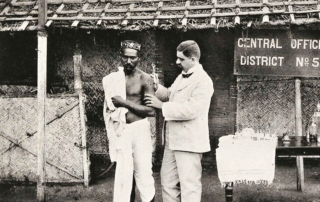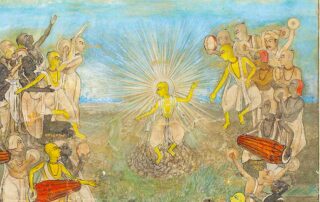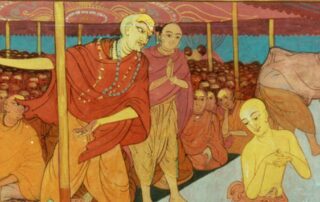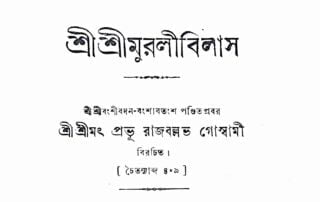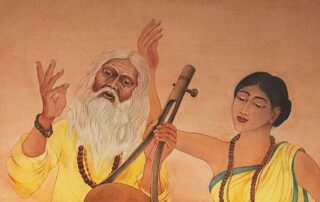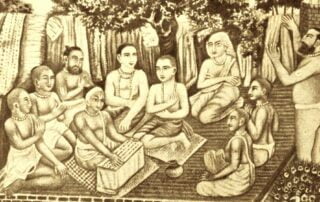Articles by Śrīla Bhaktivinoda Ṭhākura
Discover the profound wisdom of Śrīla Bhaktivinoda Ṭhākura, through our vast collection of his written articles that explore various aspects of Gauḍiya Vaiṣṇavism. Gain valuable insights into the path of bhakti-yoga as you delve into the teachings of this celebrated vaiṣṇava luminary. Our user-friendly interface makes it easy to access and explore the works of Bhaktivinoda Ṭhākura by topic.
Articles by Śrīla Bhaktivinoda Ṭhākura
Discover the profound wisdom of Śrīla Bhaktivinoda Ṭhākura, through our vast collection of his written articles that explore various aspects of Gauḍiya Vaiṣṇavism. Gain valuable insights into the path of bhakti-yoga as you delve into the teachings of this celebrated vaiṣṇava luminary. Our user-friendly interface makes it easy to access and explore the works of Bhaktivinoda Ṭhākura by topic.
Vigata Vatsarera Samālocanā (A Review of the Previous Year)
Vigata Vatsarera Samālocanā (A Review of the Previous Year) was first published in Sajjana Toṣaṇī, Vol. 11 issue 1 in 1899. In this review, Bhaktivinoda Ṭhākura describes the hardships of the previous year, in particular the outbreak of the Kolkata plague and lack of cow protection. He also describes some of the positive aspects such as the preaching and nagara-saṅkīrtana.
Bhek Dhāraṇa (Accepting the Dress of a Bābājī)
Bhek Dhāraṇa (Accepting the Dress of a Bābājī) was first published in Sajjana Toṣaṇī Vol. 2 issue 7 in 1885. In this article, Bhaktivinoda Ṭhākura discusses bhek-dhāraṇa (the acceptance of the bābājī āśrama) and how those who have polluted it are ‘a black spot on Vaiṣṇava dharma.’
Śrī Caitanya-bhāgavata
‘Śrī Caitanya-bhāgavata’ was first published in Sajjana Toṣaṇi, Vol. 13 issue 1 in 1901. Śrīla Bhaktivinoda Ṭhākur reviews a new edition of Śrī Caitanya Bhāgavata by Atula Kṛṣṇa Gosvāmī. While the Thākura is very happy for the most part with the publication, he also points out some defects.
Prabodhānanda and Prakāśānanda
In this article, ‘Prabodhānanda and Prakāśānanda’ first published in Sajjana Toṣaṇī, Vol. 13. issue 1 in 1901 under the title ‘Samālocana’, Śrīla Bhaktivinoda Ṭhākura reviews a book which claims that the Vaiṣṇava ācārya Prabodhānanda Sarasvatī and the māyāvādī Prakāśānanda Sarasvatī are one and the same person.
The Glory of Ārya Dharma Within Pure Sampradāyas (Viśuddha Sāmpradāyikatāī Ārya Dharmera Gaurava)
Viśuddha Sāmpradāyikatāī Ārya Dharmera Gaurava (The Glory of Ārya Dharma Within Pure Sampradāyas) was first published in Sajjana Toṣaṇi, Vol.3 issue 3 in 1886. In this article Bhaktivinoda Ṭhākura explains how sectarianism and the sampradāya concept of the Vedas are not the same thing. He also discusses the dangers of mixing various ideologies with hari-bhakti.
‘Śrī Muralī Vilāsa’
‘Śrī Muralī Vilāsa’ was first published in Sajjana Toṣaṇī, Vol.6 issue 4 in 1894. Śrīla Bhaktivinoda discusses the book Muralī Vilāsa by Śrī Rāja-vallabha Gosvāmī, a descendant of Śrīla Vaṁśīvadanānanda Ṭhākura, and also explains the concept of kalpa-bheda in harmonising chronological inconsistencies in the ācārya’s works.
Vaiṣṇava Granthāvalī
‘Vaiṣṇava Granthāvalī’ was first published in Sajjana Toṣaṇī, Vol.10 issue 12 in 1899. Bhaktivinoda Ṭhākura reviews a book that includes three texts by the bāulas and sahajiyās, and the Ṭhākura gives his opinion.
Samālocana (A Critique)
Samālocana (A Critique) was first published in Sajjana Toṣaṇī, Vol.5 issue 1 in 1893. In this article, Bhaktivinoda Ṭhākura reviews eight new publications including Caitanya-candrāmṛta, Gaura-gaṇoddeśa Dīpikā and Vāṁśī Śikṣā.
Rādhā-kuṇḍa and Śyāma-kuṇḍa
In this short article, ‘Rādhā-kuṇḍa and Śyāma-kuṇḍa’ first published in Sajjana Toṣaṇī, Vol.7 issue 11 in 1895, Bhaktivinoda Ṭhākura shares news with his readers concerning the renovation of Rādhā-kuṇḍa and Śyāma-kuṇḍa in Vraja-maṇḍala.
The Association of Sādhus (Sādhu-jana-saṅga)
Sādhu-jana-saṅga (The Association of Sādhus) was first published in Sajjana Toṣaṇi, Vol.10 issue 4 in 1898. Here in this article, Bhaktivinoda Ṭhākura describes the different categories of humans, and how everyone is in need of sādhu-saṅga in order to advance in their spiritual lives.

